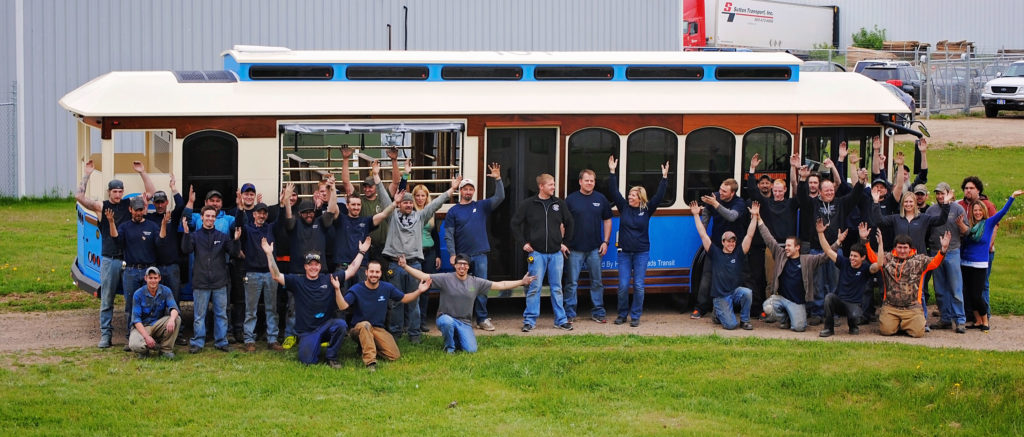A family-owned company in the Wisconsin Northwoods has become a leader in manufacturing trackless trolleys that add a historic air to business districts, tourist destinations, and college campuses. The vehicles replicate nostalgic 1800s streetcars, but are built on a truck chassis that provides the safety features today’s transit industry requires.
Kristina Pence-Dunow became involved in Hometown Trolley when she married into the family-owned business, which produced its first trolley in 1978. In 1991, Kristina became the President and CEO of the company, later divorcing in 1996 when her spouse chose to exit from the business and pursue his passion for racing. With two young children to raise, Kristina kept the company going while she pursued a degree in Business Administration at UW-Green Bay. She graduated in 2012 at age 37.
At the time, a half-dozen trolley manufacturers competed at volumes around 25 to 30 vehicles per year. Then a major bus manufacturer targeted the market and achieved sales of close to 100 trolleys a year in their trolley division. “They chose not to innovate, just focus on volume. We decided to respond by investing in our innovation,” Kristina said.
GROWTH BRINGS RISK
Kristina married an engineer who became “Mr. Innovation” for the business, developing a full-battery electric trolley in 2011. By 2012, Hometown Trolley was outgrowing its 6000-square-foot building. A suitable property stood across the street, but Kristina needed confidence to take the risk. Then, she met Chuck Brys, a consultant with the SBDC at UW–Green Bay with an extensive background running manufacturing companies. “When I first toured Hometown Trolley, I saw a fascinating opportunity,” Chuck said. “They were an imaginative bunch, spending everything they could on research and development to take the lead in the market, but they were hamstrung by that facility.” The company had also begun to evolve a new distribution network. “I thought the combination of innovation and distribution poised them to do something special,” Chuck said.
With Chuck’s help, Kristina prepared a business plan that led to a loan from WEDC. Chuck was instrumental in negotiating the loan and a new banking relationship, but their biggest step together still lay ahead.
RESPONDING TO COMPETITION WITH ACQUISITION
By 2013, the large competitor’s tactics were causing a price war in the trolley marketplace. “It was strictly a price-based business and Hometown Trolley was a small player—not good,” Chuck recalled. Kristina said, “Chuck looked me in the eye and said, ‘Why don’t you buy them?’ A couple of years later, we did!” She had never even considered approaching the $300+ million company but, energized by Chuck’s confidence, she emailed the CEO in 2015. His “no” became a “yes” and a year later. In 2016, Hometown Trolley finalized the purchase. Tools provided by Chuck and the SBDC helped Hometown Trolley secure an SBA loan to help with the acquisition.
Accomplishments with the SBDC of UW–Green Bay:
- Strategic planning for business expansion
- Mentoring and consultation on acquisition
- Identifying additional sources of funding
WHAT’S NEXT FOR HOMETOWN TROLLEY
Chuck has helped Kristina plan future expansions into new product lines and brands. In 2014, Hometown Trolley introduced its latest innovation: a handicap-accessible low- oor (ramp-entry) trolley. After three years it is now moving into full production. In this industry, “A lot goes into developing your product before you can bring it to market,” Kristina said. “We knew the low- floor innovation was going to make sales take off, but it was Chuck who helped me trust that I could do it.”
“Hometown Trolley saw the trends—energy conservation, an aging population” and responded with their battery and low- floor options, Chuck observed. “Their real objective was to get trolley specifications designed around their capability as opposed to price alone. With that, they out flanked their competition. It moved them from a small player to a market leader.”
